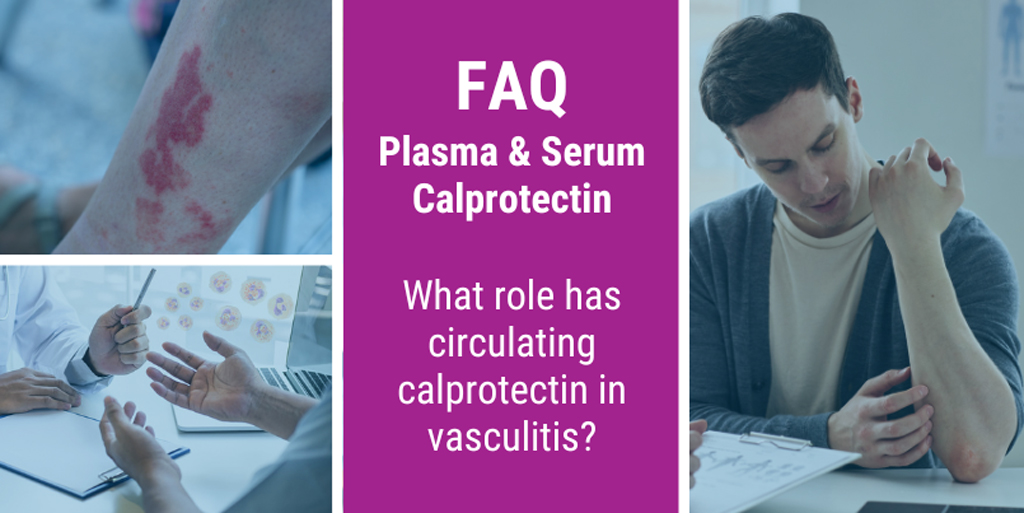
Vasculitis and rheumatic diseases
Vasculitis is a group of disorders characterised by inflammation of the blood vessels, which can affect arteries, veins, and capillaries of different sizes. The inflammation causes the walls of the blood vessels to thicken, narrowing the passageway and restricting blood flow. This can lead to organ and tissue damage, with symptoms varying depending on the location and severity of the affected vessels.1-3
Vasculitis can be a primary disorder or occur secondary to other conditions, such as infections, medications, or malignancies. However, it is often associated with autoimmune rheumatic diseases, where the body's immune system mistakenly attacks its own tissues, including rheumatoid arthritis (RA), systemic lupus erythematosus (SLE) and Sjögren's syndrome.3
The relationship between vasculitis and rheumatic diseases is complex, as they share common pathogenic mechanisms involving autoimmunity, inflammation, and endothelial cell activation. Vasculitis can be a presenting feature of an underlying rheumatic disease or develop during the course of the illness.4,5
Calprotectin as marker for inflammation activity
Circulating calprotectin has been proven as sensitive and accurate marker for disease activity in several inflammatory conditions, including RA and JIA. In these and other rheumatic conditions calprotectin has shown especially great value in assessment of the disease despite low disease activity and prediction of relapse as well as monitoring of treatment response.
Several studies have investigated the use of serum or plasma calprotectin as inflammation and activity biomarker in different forms of vasculitis, including ANCA-associated vasculitis (AAV)6-9, Kawasaki disease (KD)10-13 and large-vessel vasculitis giant cell arteritis (GCA).14,15
Phagocyte recruitment and secretion of pro-inflammatory calprotectin are one of the drives of vessel inflammation and disease etiology of vasculitis.14 Additionally, increased calprotectin in glomerular infiltrating macrophages and monocytes has been linked to glomerulonephritis, a common complication of vasculitis.9,16
Correspondingly circulating calprotectin concentrations are increased in vasculitis patients versus healthy individuals,9,12,14 active disease compared to inactive or remission7-9 and disease complication,8-11 proposing calprotectin as promising marker to predict or/and detect active disease.
Calprotectin for vasculitis patient follow-up
Assessment of disease activity, treatment response and valuation of relapse risk are crucial areas for biomarker guided decision making for rheumatologist treating vasculitis patients. In line with other autoinflammatory conditions, where calprotectin is established as valuable and sensitive marker for disease activity, an increasing number of reports highlights a diagnostic and predictive role of circulating calprotectin in vasculitis.
In Kawasaki disease, patients under IVIG (intravenous immune globulin) therapy, calprotectin levels decreased significantly within only 24 hours in responders while calprotectin continued to increase in non-responders.12 In ANCA-associated vasculitis (AAV) patients, calprotectin levels were significantly lower at two different time points of treatment (1 month and 6 months) in non-relapse versus relapse patients.9 Another study in AAV showed that increasing levels of calprotectin can identify patients on rituximab at risk for relapse, while CRP as traditional inflammation marker remained suppressed before relapse.6
Even after acute illness calprotectin can inform about ongoing inflammation. In Kawasaki patients 1 year post active disease, calprotectin was elevated exclusively in patients with giant coronary artery aneurysms, marking these patients with ongoing inflammation for continued follow up.10,11
Circulating calprotectin as valuable tool in vasculitis
In summary, circulating calprotectin has been described in several different forms of vasculitis showing great potential as sensitive marker for detection and assessment of inflammatory activity as well as for monitoring of treatment response. Hence calprotectin can serve as valuable tool for treatment and disease assessment in vasculitis in line with its established value in other fields of rheumatology.
Learn more about calprotectin in blood:
What type of assay is the Gentian Calprotectin Immunoassay GCAL®?
What is calprotectin’s role in neutrophil activation?
What is the value of calprotectin in blood as biomarker in IBD?
What is the clinical value of calprotectin in sepsis & severe infections?
Is calprotectin upregulated in sepsis in COVID-19?
What role can plasma & serum calprotectin play in severe COVID-19?
How is calprotectin useful to monitor treatment response in rheumatoid arthritis?
How is calprotectin useful in clinical assessment of rheumatoid arthritis?
What is the value of calprotectin in JIA & Still's disease?
Gentian GCAL® Calprotectin Immunoassay
The Gentian GCAL® Calprotectin Immunoassay is the first turbidimetric assay for the quantitative measurement of calprotectin in plasma and serum intended as an aid in the detection and assessment of inflammation and inflammatory response to infections. The open channel assay can be applied on a wide range of automated clinical chemistry analysers.
GCAL® is CE-marked and IVDR certified.
Get in touch
Explore GCAL® in your clinical practice and laboratory - fill out the form or send an email to marketing@gentian.com for more information about the product and prices.
References:
- Watts RA et al. Global epidemiology of vasculitis. Nat Rev Rheumatol. 2022
- ClevelandClinic. https://my.clevelandclinic.org/health/diseases/12101-vasculitis.
- ArthritisFoundation. https://www.arthritis.org/diseases/vasculitis.
- Danning CL et al. Vasculitis associated with primary rheumatologic diseases. Curr Opin Rheumatol. 1998
- Mislav R and R. Josipa, Vasculitis and Vasculopathy in Rheumatic Diseases, in Updates in the Diagnosis and Treatment of Vasculitis, I.S. Lazaros and K. Christina, Editors. 2013, IntechOpen: Rijeka. p. Ch. 7.
- Pepper RJ et al. Association of Serum Calprotectin (S100A8/A9) Level With Disease Relapse in Proteinase 3-Antineutrophil Cytoplasmic Antibody-Associated Vasculitis. Arthritis Rheumatol. 2017
- Anton-Pampols P et al. Combining neutrophil and macrophage biomarkers to detect active disease in ANCA vasculitis: a combinatory model of calprotectin and urine CD163. Clin Kidney J, 2023
- Martinez Valenzuela L et al. Calprotectin as a smoldering activity detection tool and renal prognosis biomarker in ANCA associated vasculitis. PLoS One, 2018
- Pepper RJ et al. Leukocyte and serum S100A8/S100A9 expression reflects disease activity in ANCA-associated vasculitis and glomerulonephritis. Kidney Int, 2013
- Hoshino S et al. Biomarkers of inflammation and fibrosis in young adults with history of Kawasaki disease. Int J Cardiol Heart Vasc, 2021
- Lech M et al. Circulating Markers of Inflammation Persist in Children and Adults With Giant Aneurysms After Kawasaki Disease. Circ Genom Precis Med, 2019
- Hirono K et al. Expression of myeloid-related protein-8 and -14 in patients with acute Kawasaki disease. J Am Coll Cardiol, 2006
- Weng KP et al. Prediction Model for Diagnosis of Kawasaki Disease Using iTRAQ-Based Analysis. Children (Basel), 2021
- Foell D et al. Early recruitment of phagocytes contributes to the vascular inflammation of giant cell arteritis. J Pathol, 2004
- Brun JG et al. A longitudinal study of calprotectin in patients with polymyalgia rheumatica or temporal arteritis: relation to disease activity. Scand J Rheumatol, 2005
- Frosch M et al. Expression of MRP8 and MRP14 by macrophages is a marker for severe forms of glomerulonephritis. J Leukoc Biol, 2004
This website may contain information about products that are not registered for use in your country of residence and may not comply with applicable laws or regulations in that country. We do not take any responsibility for accessing such information in those circumstances.
![]()




.jpg)
.jpg)